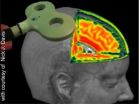(Press-News.org) Echolocating bats have historically been classified into two groups: 'loud' aerial hawkers who catch flying insects on the wing and 'whispering' gleaners that pick up prey from the ground. While some bat species can forage in multiple ways, others have limited flexibility in the amplitude of their echolocation calls.
Dr Talya Hackett and colleagues studied the desert long-eared bat (Otonycteris hemprichii), said to be a passive 'whispering' gleaner that picks up ground-dwelling invertebrates, such as scorpions, from the desert floor.
Using an acoustic tracking system, the researchers recorded the bats flying at four different foraging and drinking sites in the Arava and Judean Deserts in Israel. They then compared the bats' flight height, flight speed, call duration, pulse interval and source levels with those of other gleaning bats.
Differences were found in all these variables, with the most striking being the source levels: bats were recorded calling at an average of 119 decibels, akin to a 747 jet on take-off, when around 75, akin to a car engine, is more usual when gleaning (though these sounds occur at a high frequency, beyond the range of human hearing). Analysis of the bats' faeces also indicated that their diet included prey species capable of flight, such as flies, moths, and beetles. This suggests that the bats switched from passive gleaning to capturing airborne insects (aerial hawking).
Dr Hackett said: "Although whispering bats have been known to opportunistically catch insects on the wing, this doesn't appear to be the case here. All the bats' calls we recorded were loud and we didn't observe any low flying search tactics which suggests that the bats were exclusively aerial hawking."
Gleaning bats, like the ones in this study, usually have long ears for the detection of faint sound cues and low wing loading to allow them to carry heavy loads – features that increase drag and are linked to slower flight. So why would bats adapted to one foraging mode (gleaning), adopt another (hawking)?
Co-author Dr Marc Holderied said: "Changes in environmental conditions or prey availability could explain this change in the bats' behaviour. We studied them towards the end of an exceptionally hot and dry summer so it's likely the usual prey animals were scarcer: desert scorpions, for example, become more inactive during dry conditions. As a result, the bats might have entered different habitats with artificial irrigation or attacked different prey, adopting a different foraging mode when their typical prey was scarce."
Not only did the desert long-eared bat switch foraging modes but it also drastically altered both its call and flight behaviour when doing so. The variability in source levels recorded was the most extensive change seen in any bat species, indicating that perhaps bats are more flexible in their echolocation behaviour than previously understood.
INFORMATION:
Paper
'A whispering bat that screams: bimodal switch of foraging guild from gleaning to aerial hawking in the desert long-eared bat' by Talya D. Hackett, Carmi Korine and Marc W. Holderied in the Journal of Experimental Biology
Bats change strategy when food is scarce
2014-09-04
ELSE PRESS RELEASES FROM THIS DATE:
Visualising plastic changes to the brain
2014-09-04
Tinnitus, migraine, epilepsy, depression, schizophrenia, Alzheimer's: all these are examples of diseases with neurological causes, the treatment and study of which is more and more frequently being carried out by means of magnetic stimulation of the brain. However, the method's precise mechanisms of action have not, as yet, been fully understood. The work group headed by PD Dr Dirk Jancke from the Institut für Neuroinformatik was the first to succeed in illustrating the neuronal effects of this treatment method with high-res images.
Painless Therapy
Transcranial magnetic ...
Harvard & Cornell researchers develop untethered, autonomous soft robot
2014-09-04
New Rochelle, NY, September 4, 2014--Imagine a non-rigid, shape-changing robot that walks on four "legs," can operate without the constraints of a tether, and can function in a snowstorm, move through puddles of water, and even withstand limited exposure to flames. Harvard advanced materials chemist George Whitesides, PhD and colleagues describe the mobile, autonomous robot they have created in Soft Robotics, a peer-reviewed journal from Mary Ann Liebert, Inc., publishers. The article is available on the Soft Robotics website.
In "A Resilient, Untethered Soft Robot," ...
Intestinal barrier damage in multiple sclerosis
2014-09-04
Researchers at Lund University have published new research findings on the role of the intestinal barrier in the autoimmune disease multiple sclerosis (MS).
Within medical science, it is not known for certain how MS develops or why the body's immune system attacks cells in the central nervous system. Inflammation develops for an unknown reason, which hinders transport of neural impulses. This can produce various physical and mental symptoms, including a loss of sensation, motor difficulties, blurred vision, dizziness and tiredness.
The present study investigates whether ...
Moscow Institute of Physics and Technology specialists studied jet fuel ignition
2014-09-04
Researchers from Moscow Institute of Physics and Technology, Viktor Zhukov, Vladislav Sechenov and Andrei Starikovsky, have published experimental data on the combustion of jet fuel in the journal Fuel. The results of their research are important for simulating processes in jet engines.
In their paper, the scientists described how quickly a mixture of jet fuel and oxygen ignites depending on different conditions. This value, called the induction period or combustion delay period, was defined for different temperatures, pressure values and blending ratios. The data obtained ...
Should scientists handle retractions differently?
2014-09-04
It is one of the highest-profile cases of scientific fraud in memory: In 2005, South Korean researcher Woo-Suk Hwang and colleagues made international news by claiming that they had produced embryonic stem cells from a cloned human embryo using nuclear transfer. But within a year, the work had been debunked, soon followed by findings of fraud. South Korea put a moratorium on stem-cell research funding. Some scientists abandoned or reduced their work in the field.
But the case is not so simple: By 2007, other stem-cell researchers had found that the debunked research ...
Students report greater learning gains in traditional science courses
2014-09-04
Students taking traditional, in-class science courses reported higher perceived learning gains than students enrolled in online distance education science courses. Notably, African-American students taking traditional science courses self-reported greater affective and psychomotor learning gains than students taking online science courses.
These are the key findings of a new study co-authored by a Clemson University researcher and published in the most recent issue of Black History Bulletin.
The purpose of the study, funded by a grant from the National Science Foundation ...
Drexel team unveils Dreadnoughtus: A gigantic, exceptionally complete sauropod dinosaur
2014-09-04
This news release is available in Spanish.
PHILADELPHIA (September 4, 2014) – Scientists have discovered and described a new supermassive dinosaur species with the most complete skeleton ever found of its type. At 85 feet (26 m) long and weighing about 65 tons (59,300 kg) in life, Dreadnoughtus schrani is the largest land animal for which a body mass can be accurately calculated. Its skeleton is exceptionally complete, with over 70 percent of the bones, excluding the head, represented. Because all previously discovered supermassive dinosaurs are known only from relatively ...
Phase III FIRST™ (MM-020/IFM 07-01) trial of REVLIMID® (lenalidomide) plus dexamethasone in newly diagnosed multiple myeloma patients who are not candidates for stem cell transplant published in New E
2014-09-04
SUMMIT, N.J. (Sept. 4, 2014) – Celgene Corporation (NASDAQ:CELG) today announced that data from FIRST (MM-020/IFM 07-01)—an open-label phase III randomized study of continuous REVLIMID (lenalidomide) in combination with dexamethasone in patients newly diagnosed with multiple myeloma (NDMM) who are not candidates for stem cell transplant—have been published in the Sept. 4 issue of the New England Journal of Medicine.
Initial findings, including that the trial had met its primary endpoint of progression free survival (PFS), were reported during the plenary session at the ...
Nano-pea pod model widens electronics applications
2014-09-04
New York | Heidelberg, 4 September 2014 -- Periodic chain-like nanostructures are widely used in nanoelectronics. Typically, chain elements include the likes of quantum rings, quantum dots, or quantum graphs. Such a structure enables electrons to move along the chain, in theory, indefinitely. The trouble is that some applications require localised electrons—these are no longer in a continuous energy spectrum but in a discrete energy spectrum, instead. Now, a new study by Russian scientists identifies ways of disturbing the periodicity of a model nanostructure to obtain ...
Speaking of chemistry: Rethinking football head injuries (video)
2014-09-04
WASHINGTON, Sept. 4, 2014 — Football season is here, and along with thousands of lost hours of productivity from fantasy teams, there's a renewed discussion on the impact of head injuries on players. This week's Speaking of Chemistry focuses on a brain disorder called chronic traumatic encephalopathy (CTE), whose symptoms include memory loss, depression and aggressive or violent behavior. Current detection methods can only identify CTE after a patient has died, leaving many NFL players with a diagnosis that came too late. Now doctors are developing a way to spot CTE in ...



